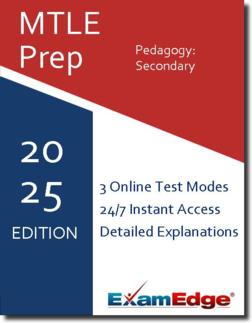MTLE Pedagogy: Secondary (014) Practice Tests & Test Prep by Exam Edge - Topics
Based on 25 Reviews
- Real Exam Simulation: Timed questions and matching content build comfort for your MTLE Pedagogy: Secondary test day.
- Instant, 24/7 Access: Web-based MTLE Pedagogy Secondary (Grades 5-12) practice exams with no software needed.
- Clear Explanations: Step-by-step answers and explanations for your MTLE exam to strengthen understanding.
- Boosted Confidence: Reduces anxiety and improves test-taking skills to ace your MTLE Pedagogy Secondary (Grades 5-12) (014).

Understanding the exact breakdown of the MTLE Pedagogy Secondary (Grades 5-12) test will help you know what to expect and how to most effectively prepare. The MTLE Pedagogy Secondary (Grades 5-12) has multiple-choice questions The exam will be broken down into the sections below:
| MTLE Pedagogy Secondary (Grades 5-12) Exam Blueprint | ||
|---|---|---|
| Domain Name | ||
| Student Development and Learning | ||
| Learning Environment | ||
| Instruction and Assessment | ||
| Professional Roles and Responsibilities |


